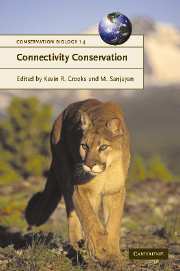Book contents
- Frontmatter
- Contents
- List of contributors
- Acknowledgements
- 1 Connectivity conservation: maintaining connections for nature
- PART I Approaches to connectivity research
- Introduction: Connectivity research—what are the issues?
- 2 Landscape connectivity: a return to the basics
- 3 Connectivity and metapopulation dynamics in highly fragmented landscapes
- 4 Genetics and landscape connectivity
- 5 Connectivity at the land–water interface
- 6 Influence of natural landscape fragmentation and resource availability on distribution and connectivity of gray wolves (Canis lupus) in the archipelago of coastal British Columbia, Canada
- 7 Migratory connectivity
- 8 Connectivity in marine ecosystems: the importance of larval and spore dispersal
- 9 Connectivity and wide-ranging species in the ocean
- 10 Hydrologic connectivity: a neglected dimension of conservation biology
- 11 Connectivity and ecosystem services: crop pollination in agricultural landscapes
- PART II Assessing connectivity
- PART III Challenges and implementation of connectivity conservation
- Index
- References
9 - Connectivity and wide-ranging species in the ocean
Published online by Cambridge University Press: 24 May 2010
- Frontmatter
- Contents
- List of contributors
- Acknowledgements
- 1 Connectivity conservation: maintaining connections for nature
- PART I Approaches to connectivity research
- Introduction: Connectivity research—what are the issues?
- 2 Landscape connectivity: a return to the basics
- 3 Connectivity and metapopulation dynamics in highly fragmented landscapes
- 4 Genetics and landscape connectivity
- 5 Connectivity at the land–water interface
- 6 Influence of natural landscape fragmentation and resource availability on distribution and connectivity of gray wolves (Canis lupus) in the archipelago of coastal British Columbia, Canada
- 7 Migratory connectivity
- 8 Connectivity in marine ecosystems: the importance of larval and spore dispersal
- 9 Connectivity and wide-ranging species in the ocean
- 10 Hydrologic connectivity: a neglected dimension of conservation biology
- 11 Connectivity and ecosystem services: crop pollination in agricultural landscapes
- PART II Assessing connectivity
- PART III Challenges and implementation of connectivity conservation
- Index
- References
Summary
INTRODUCTION
On land, the study of connectivity grew chiefly from the desire to conserve migratory routes and extensive home ranges of large wide-ranging of mammals. These charismatic animals served as the basis for an expanding and influential branch of conservation biology. The marine analogues of the wildebeest of the plains and the wolves of Yellowstone National Park are the wide-ranging creatures of the sea – cetaceans (whales and dolphins), elasmobranchs (sharks and rays), pinnipeds (seals and sea lions), sea turtles, and large migratory teleost fish such as tuna. Single migration events of these species range from hundreds to tens of thousands of kilometers (Alerstam et al. 2003) and patterns of connectivity between populations and between habitats of these organisms provide a distinct interpretation of connectivity among large animal populations.
Connectivity is dependent upon the lens with which the landscape (or seascape) is viewed and upon how the seascape is functionally treated by the species in question (Taylor 1993; Tischendorf and Fahrig 2000; Crooks and Suarez Chapter 18). The view from the eye of a tuna, whale, or sea turtle differs substantially from that of their terrestrial counterparts. Likewise, patterns of connectivity for wide-ranging species in the ocean can differ from those of other marine species such as algae, coral, and reef fish. Larval transport and reef fish connectivity are the subject of an extensive body of research and are thus treated separately in this volume (DiBacco et al. Chapter 8).
- Type
- Chapter
- Information
- Connectivity Conservation , pp. 213 - 232Publisher: Cambridge University PressPrint publication year: 2006
References
- 6
- Cited by

